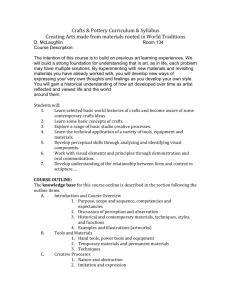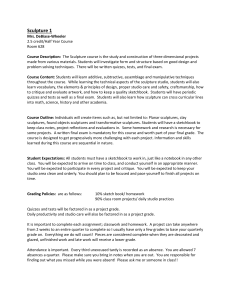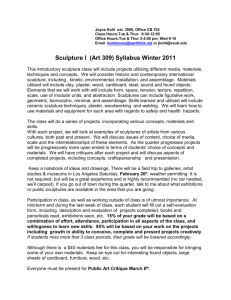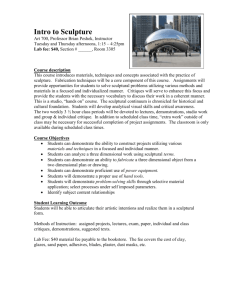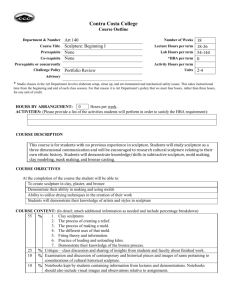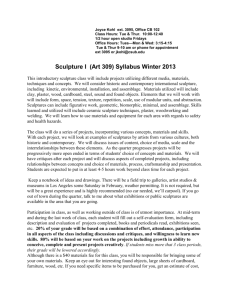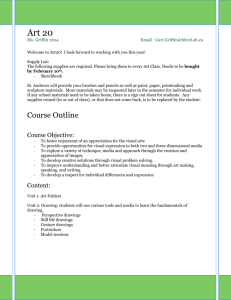Intro to Sculpture (Art 128)
advertisement
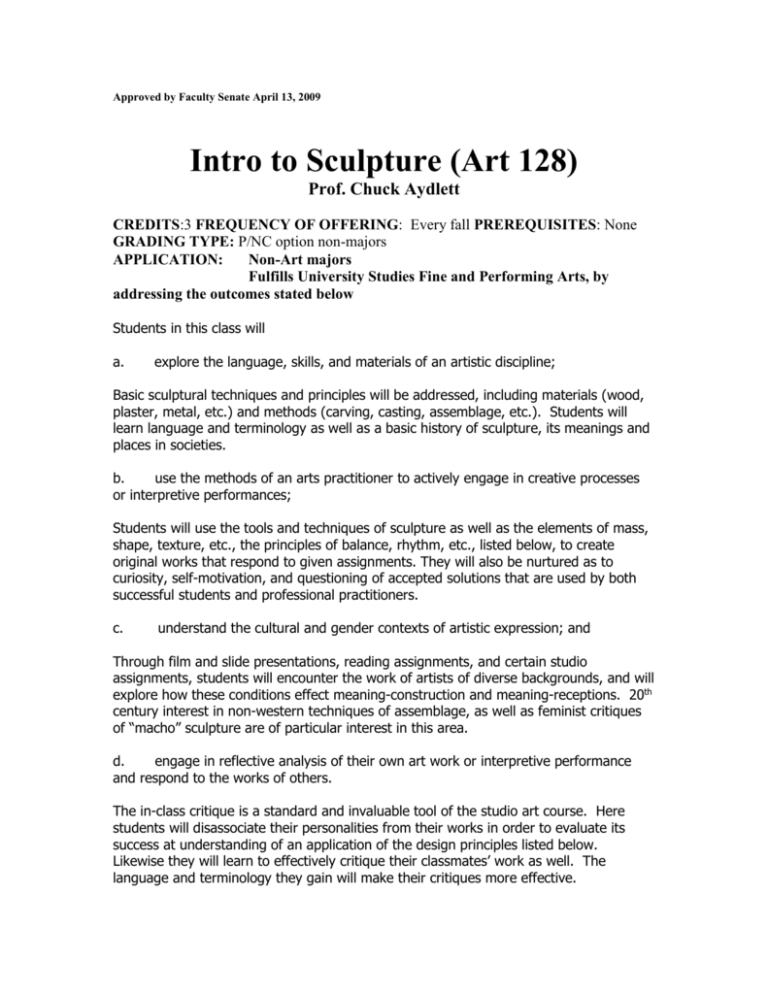
Approved by Faculty Senate April 13, 2009 Intro to Sculpture (Art 128) Prof. Chuck Aydlett CREDITS:3 FREQUENCY OF OFFERING: Every fall PREREQUISITES: None GRADING TYPE: P/NC option non-majors APPLICATION: Non-Art majors Fulfills University Studies Fine and Performing Arts, by addressing the outcomes stated below Students in this class will a. explore the language, skills, and materials of an artistic discipline; Basic sculptural techniques and principles will be addressed, including materials (wood, plaster, metal, etc.) and methods (carving, casting, assemblage, etc.). Students will learn language and terminology as well as a basic history of sculpture, its meanings and places in societies. b. use the methods of an arts practitioner to actively engage in creative processes or interpretive performances; Students will use the tools and techniques of sculpture as well as the elements of mass, shape, texture, etc., the principles of balance, rhythm, etc., listed below, to create original works that respond to given assignments. They will also be nurtured as to curiosity, self-motivation, and questioning of accepted solutions that are used by both successful students and professional practitioners. c. understand the cultural and gender contexts of artistic expression; and Through film and slide presentations, reading assignments, and certain studio assignments, students will encounter the work of artists of diverse backgrounds, and will explore how these conditions effect meaning-construction and meaning-receptions. 20th century interest in non-western techniques of assemblage, as well as feminist critiques of “macho” sculpture are of particular interest in this area. d. engage in reflective analysis of their own art work or interpretive performance and respond to the works of others. The in-class critique is a standard and invaluable tool of the studio art course. Here students will disassociate their personalities from their works in order to evaluate its success at understanding of an application of the design principles listed below. Likewise they will learn to effectively critique their classmates’ work as well. The language and terminology they gain will make their critiques more effective. COURSE SYLLABUS CATALOG DESCRIPTION: An introduction to basic sculpture techniques. No prerequisite. P/NC Option nonmajors. MAJOR FOCUS AND OBJECTIVES OF THE COURSE Students are introduced to several sculptural materials (selected from clay, plaster, wood, or cold metal) and techniques (selected from modeling, mold-making, casting, fabricating, carving and assemblage). The course develops students’ perceptual, creative, technical, and problem-solving skills in a sculptural context. Elements and principles of design are identified and employed. Aesthetic judgment and good studio practice are cultivated. Students will: 1. Learn selected basic world histories of sculpture and become aware of some contemporary sculptural ideas 2. Learn some basic concepts of sculpture 3. Explore a range of basic studio creative processes. 4. Learn the technical application of a variety of tools, equipment and materials 5. Develop perceptual skills through analyzing and identifying visual components 6. Work with visual elements and principles through demonstration and oral communication 7. Develop understanding of the relationship between form and content in sculpture COURSE OUTLINE: The knowledge base for this course outline is described in the section following the outline items. A. B. C. Introduction and Course Overview 1. Purpose, scope and sequence, competencies and expectancies 2. Discussion of perception and observation 3. Historical and contemporary materials, techniques, styles, and functions 4. Examples and illustrations (artworks) Tools and Materials 1. Hand tools, power tools and equipment 2. Temporary materials and permanent materials 3. Techniques Creative Processes 1. Nature and abstraction D. E. F. 2. 3. 4. 5. 6. 7. Imitation and expression Function Problem-solving Pre-conceived outcomes Influence of process and material Artist as craftsman and artisan 1. 2. 3. 4. 5. 6. 7. 8. 9. Mass, shape and form Space (including negative space) Planes and surfaces Line and silhouette Texture Light Color Gravity Time Elements Principles 1. 2. 3. 4. 5. 6. 7. 8. Proportion Balance Movement Rhythm and repetition Emphasis and dominance Function Variety Size and scale Criticism and Analysis 1. Individual and group activities 2. Verbal and written analysis 3. Relationship and form and content BASIC INSTRUCTIONAL PLAN AND METHODS UTILIZED: Introductory instruction is through lecture, slide lecture, demonstration, assigned reading, and assigned visual study (gallery or museum viewing). Primary mode of instruction is through studio practice – manipulation of tools and materials, to provide sculptural solutions to problems. Peer consultation, individual critique, group critique, sketches, journal writing, and response papers enable students to assess and evaluate their work. A series of projects are assigned which are completed during class and outside of class. Class critiques of finished work are an integral part of each project. A range of media will be used. Projects address the elements and principles of three-dimensional design as outlined above. Consideration is also given to concept, craftsmanship, originality and expression. This is essentially a problem-solving class- there are many possible solutions to any given problem. Another major objective of the class is that the participants learn the vocabulary of sculpture and employ that vocabulary during class critiques. We are a community of learners in this class. Co-operation and exchange of ideas among us all is encouraged. The completion of many projects is enhanced through co-operation. Studio safety is emphasized. Learn to use tools properly. Keep your work area clean and organized and be aware of what others are doing around you. Become familiar with equipment before using it. After working, replace all tools, clean your area, and store your projects on shelves in 109. COURSE REQUIREMENTS: A. Completion of all assigned projects B. Participation in group and individual critiques C. Sketches and journal writing D. Consistent class attendance METHODS OF EVALUATION: A. PROJECTS: Satisfactory completion of projects and their requirements in time for class critiques. B. Originality, appropriate craftsmanship, content, and dynamic visual impact of solutions. C. PARTICIPATION IN CRITIQUES Quality and quantity of participation in individual and group critiques. D. Performance in sketchbook/journal, response papers, and oral reports. SKETCHBOOKS/JOURNAL are reviewed at midterm and final times, and throughout the semester. Use your sketchbook to record information from exhibitions, slides, lectures in class, oral reports, 3-D forms you see around you, your projects, and other students’ projects. Journalize after each class on what you experienced and/or learned. Use your journal to outline reading assignments. E. CONSISTENT CLASS ATTENDANCE Attendance to each entire class is essential to understand projects, see demonstrations, view slides, take advantage of work time, participate in class discussions, and get help with your projects. Expect to work outside of class as well. Bring written proof of legitimate absence (i.e. note from your doctor or the campus health service). More than two (2) unexcused absences may result in a lowered grade. You are responsible for learning the information presented in class from other students or from the instructor during office hours. F. OBSERVANCE OF SAFETY AND CLEAN-UP PRACTICES Be sure you know how to use tools properly and use the appropriate safety equipment. Allow time for returning tools, cleaning up debris, and storing work in progress. TOOLS AND MATERIAL Sketchbook/journal – loose-leaf 8 ½” x 11” binder that includes both lined and unlined paper Appropriate clothing and shoes Lock for locker Hardware, etc. as needed Optional: Clay tools: may be purchased Personal dust mask Apron or smock OFFICE HOURS: Monday and Wednesday 30 minutes before and after class and by appointment EMAIL and Phone caydlett@winona.edu PH 457-2990 STUDIO HOURS The building and 109 and 212 studios are open to students taking classes in sculpture and ceramics: Mon-Thursday 7:30 am – 9:00 pm Fri 7:30 am – 5:00 pm Sat 10:00 am- 4:00pm Sun 12:00 noon- 4:00pm If you are in the building when it is locked by Security, you may stay as long as you like. However, you cannot leave and the re-enter. The building is closed over breaks and holidays. LOCKERS Use tape to label a locker downstairs with your name and the semester (Fall 08) You may also label a small locker under the work tables in 109, or you may sign up for a 2nd floor locker (in the Art Office, WA 204) Store your backpack, coat or jacket, tools, materials, special clothing, and small work in progress there. GENERAL STUDIO GUIDELINES During class and outside of class, replace all tools and materials after using them, and sweep up your debris. Store works-in-progress in the kiln rooms and on the shelving across from the glaze-mixing area. After critiques, some pieces may be displayed or photographed by the instructor. Unless otherwise instructed, following a final critique (but before the end of the semester) remove your work by taking it home, recycling it in an appropriate manner, or breaking it down into compact components and discarding it in the dumpster. You are responsible for the timely removal of all your work in this manner. No finished pieces can be stored in the studios after critiques.
